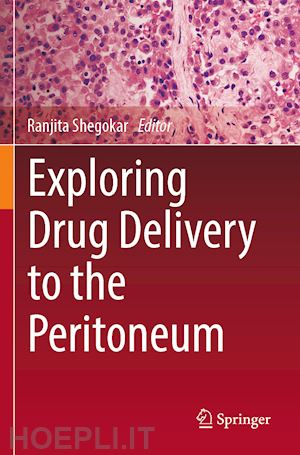
Questo prodotto usufruisce delle SPEDIZIONI GRATIS
selezionando l'opzione Corriere Veloce in fase di ordine.
Pagabile anche con Carta della cultura giovani e del merito, 18App Bonus Cultura e Carta del Docente
The Peritoneal cavity (PC) is the key metastatic site for intra-abdominal malignancies (e.g., GI tract and rectal cancer). PC sites can be used to target several other diseases where lymphatic drug delivery is desired without dumping large amounts of the drug. Till recently, it was thought that treatment with curative intent was impossible but that was challenged by the introduction of cytoreductive surgery (CRS) and heated intraperitoneal chemotherapy (HIPEC), and PIPAC (pressurized intraperitoneal aerosol chemotherapy). Recently, a growing number of preclinical and clinical studies advocate intraperitoneal (IP) chemotherapy as an alternative post-operative therapy for cancer. Although their effectiveness has been proven both experimentally and clinically, there is still little understanding of the role of drug delivery systems (DDS) in targeting drugs in the intraperitoneal (IP) cavity.
There are two main challenges one posed by IP cavity where the residence time of a small molecular weight drug (<20 kDa) is not sufficiently long to maintain therapeutic effect. This leads to frequent or continuous dosing. Another challenge is device-related or catheter-related problems, such as catheter obstruction, increased risk of infection, and bowel complications. Overall literature shows that the IP site is satisfactorily explored by clinicians but in terms of drug delivery not that much. One can see a clear-cut gap of expertise exchange between the two fields and guidelines from regulatory lawmakers on new medications.
In summary, challenges like delivery to IP cavity, tumor or organ-specific targeting, efficient tissue penetration, optimal cellular uptake and intracellular residence of a drug, biocompatibility, toxicity, etc can be easily solved by smartly designing functional drug delivery systems (both nano and micro). Nanotechnologies have always fascinated humans for several decades and are now widely explored in the biomedical field. Diverse types of nanoparticles are being explored around the world, some examples include biodegradable nanoparticles, green nanoparticles, polymeric nanoparticles, lipid nanoparticles, metal nanoparticles, graphene, carbon nanotubes, and several others. Now a day's nanoparticles are gaining interest for drug targeting of chemotherapeutic drugs, immunotherapy, and gene delivery. Whereas microparticles can be explored for delayed drug delivery to the peritoneal cavity due to relatively slow removal from IP fluid. Hydrogels or other adhesive drug delivery may help to enhance peritoneal adhesions; thereby maintaining the balance between benefit and risk. Overall, drug delivery systems are key in IP targeting. That means drug delivery specialist and clinician needs to be connected to get the best out of this route of drug administration.
The present book is a link between pharmaceutical scientists (drug formulators), clinicians, toxicologists, and regulatory experts. This book also provides a new perspective to researchers to divert or guide their research in an optimal way. Exploring Drug Delivery to the Peritoneum serves as a platform for upcoming technologies especially in the medical devices sector to face up and show potential in delivering drugs. It is a chance for commercial partners like insurance companies and the pharma industry to explore this direction.
Chapter 1: Peritoneal Organ-Anatomical and Physiological Considerations.- Chapter 2: drug delivery platforms for intra-peritoneal delivery focusing primarily on need, delivery systems, clinical progress, market and regulatory aspects.- Chapter 3: Liposomes and Lipid Nanoparticles as Peritoneal Drug Delivery Systems.- Chapter 4: Nano and micro/medicines for intraperitoneal therapy in ovarian cancer: critical overview and focus on pharmaceutical manufacturing under cGMP.- Chapter 5: Pressurized Intraperitoneal Aerosolized Chemotherapy (PIPAC): Promising Strides from India.- Chapter 6: HIPEC: Concept and Fundamentals in Colorectal Cáncer Peritoneal Mestatasis Treatment.- Chapter 7: Peritoneal Implants and Drug Delivery.- Chapter 8: Importance of Computational Models in Development of Intrapertitoneal Administration based Drug Delivery Systems for Solid Tumors.- Chapter 9: Drug Delivery Systems for peritonium : current status and Future perspectives.- Chapter 10: Exploring the Intraperitoneal Route in a New Way for Preclinical Testing.











Il sito utilizza cookie ed altri strumenti di tracciamento che raccolgono informazioni dal dispositivo dell’utente. Oltre ai cookie tecnici ed analitici aggregati, strettamente necessari per il funzionamento di questo sito web, previo consenso dell’utente possono essere installati cookie di profilazione e marketing e cookie dei social media. Cliccando su “Accetto tutti i cookie” saranno attivate tutte le categorie di cookie. Per accettare solo deterninate categorie di cookie, cliccare invece su “Impostazioni cookie”. Chiudendo il banner o continuando a navigare saranno installati solo cookie tecnici. Per maggiori dettagli, consultare la Cookie Policy.